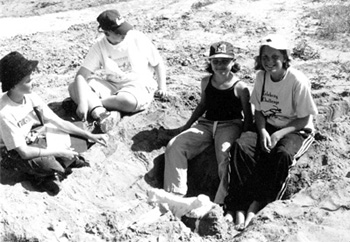 | |||||
| About Us | Contact Us | Services | Copyright | |||||
|
|||||
|
Paleontology Camps for Kids By Lori Wiens, University of Saskatchewan
A child's life is simple. Every day they get up, grab their Winnie the Pooh lunchboxes and head off to dig up marine invertebrate fossils in the Creataceous Bearpaw Formation, to explore the geological time scale and the evolution of several Mesozoic animal groups. At least, that's what they do if they go to the Paleontology Summer Day Camps for Children. The camps are the brainchild of two U of S graduates, Sean Robson (BSc'95, MSc'00) and Richard McCrea (BSc'94, BEd'95). "There was nothing like this when I was a kid," explains Robson. "I remember I had to be pulled bodily away from the natural sciences museum." Robson says the idea for the camps came from their own personal interest in science and in children. "Richard and I started these camps in 1997 to promote science and earth science in education. All kids love dinosaurs and this was ideal."
The program includes classroom lectures, lab activities and two field trips to nearby Lake Diefenbaker. Topics range from fossilization processes to ethics of collecting to the evolution of dinosaurs. It is multi-tiered, so kids can move up a level every year. Robson said he's learned a lot about the capabilities of kids to learn when they are interested in something. "The biggest lesson I've learned is not to underestimate them. We saw that the kids who were 8 and 9 years old could take more and more. It got to the point where I can teach some things at a university level. They absorb it as fast as I can dish it out and then come back for more," he says. As many girls as boys are interested in the class, and he sees it as a way to promote science for women. "Most of the kids are extremely keen when they come. Some just come for fun, but some are getting older and are thinking about a career in earth sciences," claims Robson. He says the nice thing about paleontology is that it can be done as a hobby. "You can't, as a hobbyist, get involved in nuclear physics." To further cultivate kids interest, Robson has created a Paleontology club that runs over the winters and he is now encouraging undergraduate students to get involved as mentors. As for his own aspirations, Robson sees the camps as just one step in a larger academic career. His next goal is a PhD and he would eventually like to teach at a university level. When he's gone, he hopes the camps continue to thrive. "I'm trying to interest other graduate students to take over. I would like to make the program more widespread," he says. "It's sort of a sideline, but public education is something I feel very strongly about."
This article may not be copied, distributed or reprinted in any form without permission from Green & White, the University of Saskatchewan Alumni Association Publication. To contact Green & White, please use the e-mail address provided. If you are unable to contact Green & White, please contact the Canadian Rockhound. Authorized reprints must acknowledge the author, Green & White and the Canadian Rockhound, and include the website URL addresses of Green & White and the Canadian Rockhound. The preceding article was first published in the Fall 2000 issue (p. 21) of Green & White, the official publication of the University of Saskatchewan Alumni Association. Reprinted in the Canadian Rockhound with permission from the editor.
|
||

Copyright © 2000 Canadian Rockhound
Magazine Issues |
News & Events |
Junior Rockhound |
Resources
|
|||

